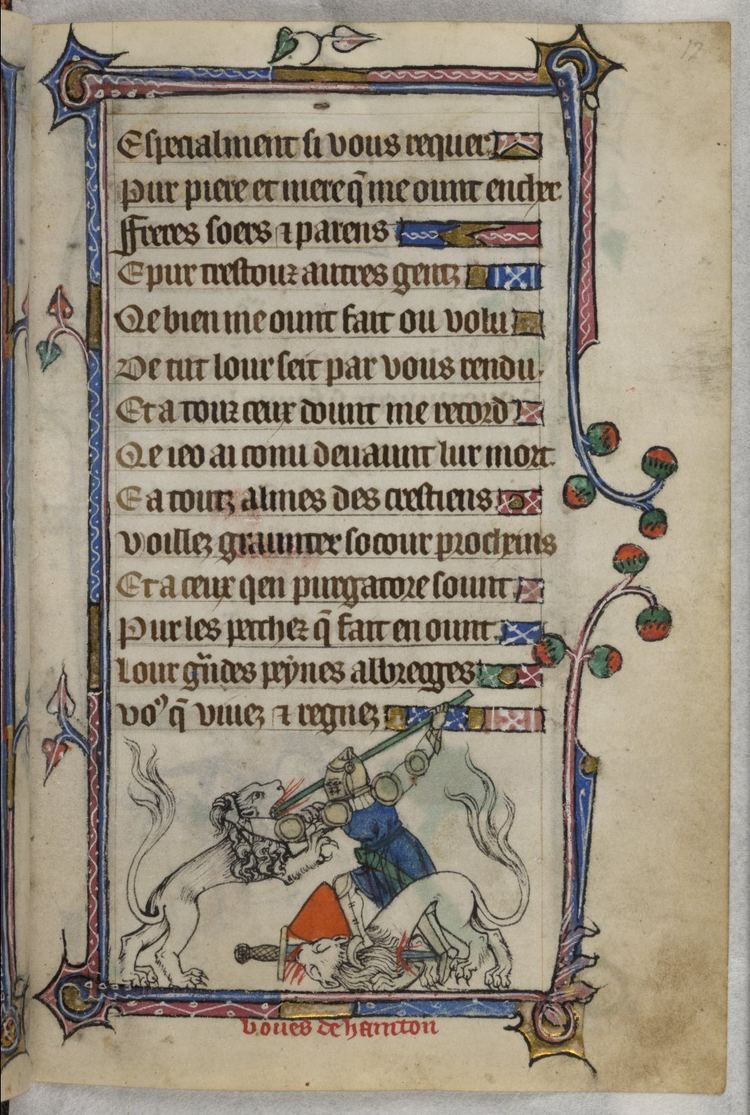 | ||
People also search for Le serve rivali, Ippolito ed Aricia, Antigona, L'isola disabitata | ||
Bevis of hampton
Bevis of Hampton (Old French: Beuve(s) or Bueve or Beavis de Hanton(n)e; Anglo-Norman: Boeve de Haumtone; Italian: Buovo d'Antona) or Sir Bevois, was a legendary English hero and the subject of Anglo-Norman, Dutch, French, English, Venetian, and other medieval metrical romances that bear his name. The tale also exists in medieval prose, with translations to Romanian, Russian, Dutch, Irish, Welsh, Old Norse and Yiddish.
Contents
- Bevis of hampton
- Tales of southampton legend sir bevis of hampton have been immortalized in a new comic book series
- Legend
- Texts
- References
Tales of southampton legend sir bevis of hampton have been immortalized in a new comic book series
Legend
Sir Bevis of Hampton (c. 1324) is a Middle English romance. It contains many themes common to that genre: a hero whose exploits take him from callow youth to hard-won maturity, ending with a serene and almost sanctified death. Supporting him are a resourceful, appealing heroine and faithful servants set against dynastic intrigue, and a parade of interesting villains, both foreign and domestic. The plot has a geographical sweep which moves back and forth from England to the Near East and through most of western Europe, replete with battles against dragons, giants, and other mythical creatures. Forced marriages, episodes of domestic violence, a myriad of disguises and mistaken identities, harsh imprisonments with dramatic escapes, harrowing rescues, and violent urban warfare fill out the protagonist's experiences. Last but not least, he has a horse of such valor that the horse's death at the end of the poem is at least as tragic as that of the heroine, and almost as tragic as that of Bevis himself. Not surprisingly though, this much variety makes the poem a difficult one to characterize with any degree of certainty, and several other factors make it a poem which is perhaps easier to enjoy than to evaluate accurately.
Bevis is the son of Man, the count of Hampton (Southampton), and Man's young wife, who is a daughter of the King of Scotland. Discontented with her marriage, Bevis's mother asks a former suitor, Doon or Devoun, emperor of Almaine (Germany), to send an army to murder Man in a forest. The plot succeeds, and the countess marries Doon. Threatened with future vengeance by her ten-year-old son, she determines to do away with him also, but Bevis is saved from death by a faithful tutor.
Bevis is subsequently sold to pirates and ends up at the court of King Hermin, whose realm is variously placed in Egypt and Armenia. The legend continues to relate the exploits of Bevis, his defeat of Ascapart, his love for the king's daughter Josiane, his mission to King Bradmond of Damascus with a sealed letter demanding his own death, his eventual imprisonment, and his final vengeance on his stepfather. After succeeding in claiming his inheritance, however, Bevis is driven into exile and separated from Josiane, with whom he is reunited only after each of them has contracted, in form only, a second union. The story also relates the hero's death and the fortunes of his two sons.
Texts
The oldest version known, Boeve de Haumtone, is an Anglo-Norman text that dates back to the first half of the 13th century. It consists of 3,850 verses written in Alexandrines.
Three continental French chansons de geste of Beuve d'Hanstone, all in decasyllables, were written in the 13th century. One is preserved in BnF Français 25516. They consist of between 10,000 and 20,000 verses. A French prose version was made before 1469.
The English metrical romance, Sir Beues of Hamtoun (see Matter of England), is founded based on some French origins, varying slightly from those that have been preserved. The oldest manuscript dates from the beginning of the 14th century. A translation into Irish survives in a 15th-century manuscript.
The printed editions of the story were most numerous in Italy, where Bovo or Buovo d'Antona was the subject of more than one poem, and the tale was interpolated in the Reali di Francia, the Italian compilation of Carolingian legend.
From Italian, it passed into Yiddish, where the Bovo-Bukh became the first non-religious book to be printed in Yiddish. The most popular and critically honored Yiddish-language chivalry romance.
In Russia, the romance attained an unparalleled popularity and became a part of Russian folklore. The Russian rendition of the romance appeared in mid-16th century, translated from a Polish or Old Belarusian version, which were in turn, translated from a Serbo-Croatian rendition of the Italian romance, made in Ragusa. The resulting narrative, called Повесть о Бове-королевиче (Povest' o Bove-koroleviche, lit. The Story of Prince Bova), gradually merged with Russian folktales, and the principal character attained many features of a Russian folk hero (bogatyr). Since the 18th century until 1918, various versions of the Povest' had been widely circulated (particularly among the lower classes) as a lubok. Such writers as Derzhavin and Pushkin praised Bova's literary value. The latter used some elements of the Povest' in his fairy tales and attempted to write a fantasy poem based on the romance. Pushkin also praised a version of Bova by Alexander Radish chev, written in 1799.
